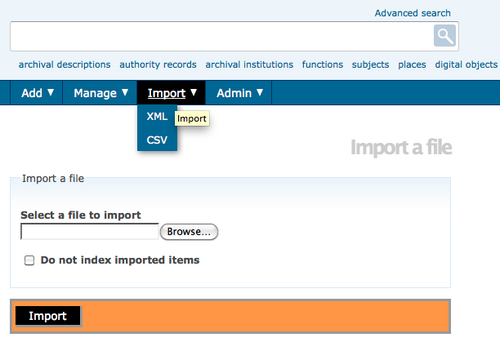Difference between revisions of "Import descriptions and terms"
Jump to navigation
Jump to search
| Line 2: | Line 2: | ||
| − | ICA-AtoM provides an import functionality that can be used to import | + | ICA-AtoM provides an import functionality that can be used to import [[Glossary#Archival description|archival descriptions]], [[Glossary#Authority record|authority records]], [[Glossary#Archival institution|archival institutions]] and [[Glossary#Term|terms]]. |
The following filetypes can be imported: | The following filetypes can be imported: | ||
| − | * EAD (archival descriptions and associated authority records, repositories and taxonomy terms) | + | * EAD (hierarchical archival descriptions and associated authority records, repositories and taxonomy terms) |
* Dublin Core XML, MODS XML (archival descriptions and associated taxonomy terms) | * Dublin Core XML, MODS XML (archival descriptions and associated taxonomy terms) | ||
* EAC (authority records) | * EAC (authority records) | ||
Revision as of 18:42, 22 November 2010
Please note that ICA-AtoM is no longer actively supported by Artefactual Systems.
Visit https://www.accesstomemory.org for information about AtoM, the currently supported version.
Main Page > User manual > Import/export > Import descriptions
ICA-AtoM provides an import functionality that can be used to import archival descriptions, authority records, archival institutions and terms.
The following filetypes can be imported:
- EAD (hierarchical archival descriptions and associated authority records, repositories and taxonomy terms)
- Dublin Core XML, MODS XML (archival descriptions and associated taxonomy terms)
- EAC (authority records)
- SKOS (hierarchical taxonomies)
- In the main menu, hover your cursor over the "Import" menu and select "XML".
- Click Browse to select a file
- Click Import
- If the file is successfully uploaded, the page will read "import completed." If there are errors in the file, the page will display a message describing the errors. However, it should still be possible to edit and view the imported descriptions. You will need to review them carefully to determine whether the errors in the import file were serious enough to affect the display of the descriptions.
- Click the "View archival description" button to go to the edit page of the highest level of description in the imported archival descriptions. You will be able to view and edit this description and its child records just as you would if you had entered them in ICA-AtoM instead of importing them.
